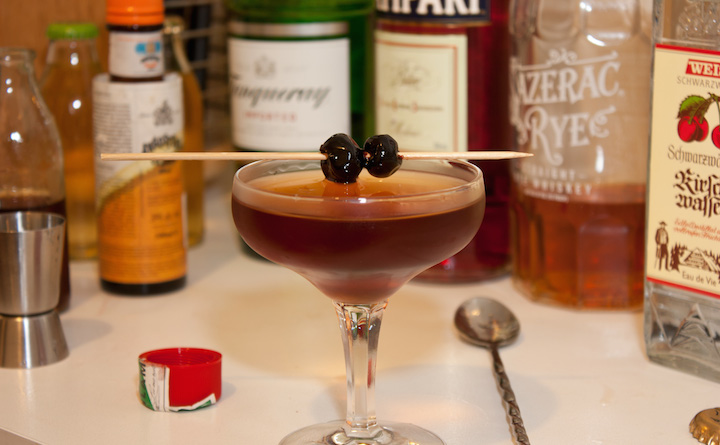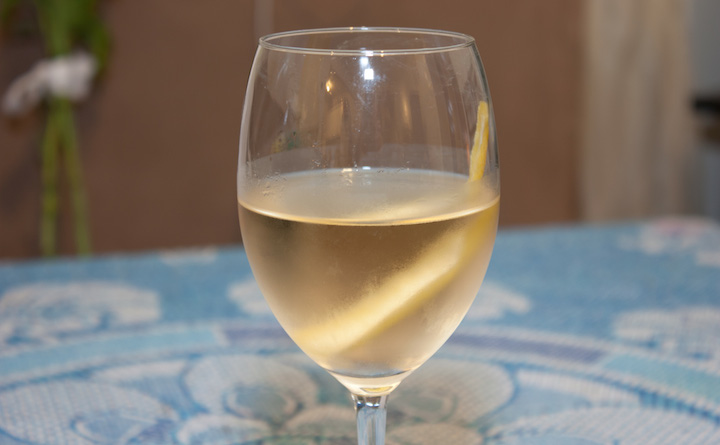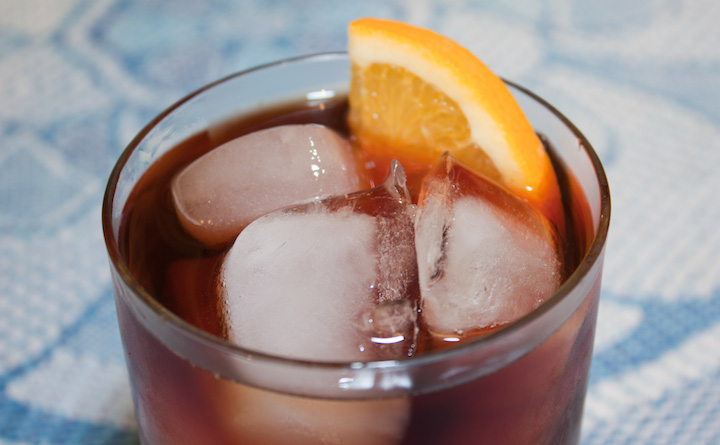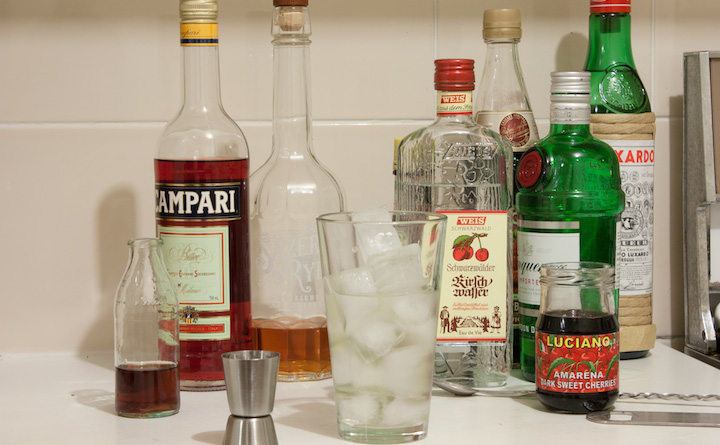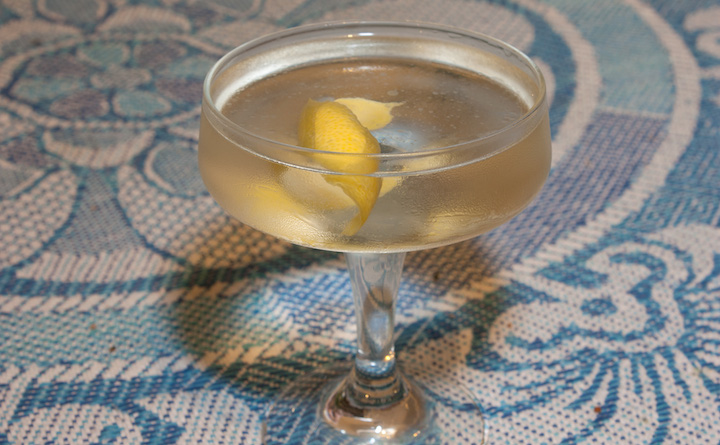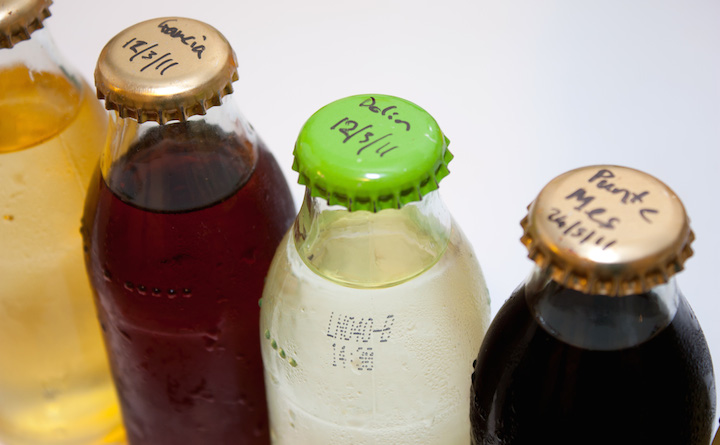
I’m sure you’ve had the experience of walking into a liquor store to be confronted by a display rack of some shiny new beverage begging to be taken home. One of the tried and true methods of selling such a product—aside from getting well-endowed young women to hand out samples—is to knock out a quick little booklet with a potted history of the brand and a list of cocktails created to showcase the stuff. While some of these cocktails go on to have a long life—the erroneously-named French Martini, for example, was created by Chambord as a means of selling their venerable raspberry liqueur outside of France—most are hamfisted concoctions that use far too much of the product in question or just so happen to specify other ingredients from the same distributor’s portfolio. Other products need no such artificial push: recently both Domaine de Canton ginger liqueur and St-Germain elderflower liqueur have become near-ubiquitous in cocktail lists, to the extent that St-Germain is sometimes pejoratively called “bartender’s ketchup”. All of these liquor companies are hoping for a kind of immortality for their product: if one of these custom- made cocktails becomes immensely popular, you’ve suddenly made your product a must-have for any bar owner.
While the products popularised in this way don’t often become time-honoured, the method of promotion is not terribly novel in itself. Harry Craddock’s famous Savoy Cocktail Book of 1930 lists several recipes that call for Hercules, a defunct proprietary formulation of wine and yerba maté. Pre-Prohibition bartenders had a bewildering array of bitters from which to choose, most of them irrevocably lost—Abbott’s, Boker’s, Caroni, and Koosh amongst them. The cornerstone books from the golden age of the cocktail—from the middle of the nineteenth century through to 1920, when Prohibition killed American bar culture—are littered with drinks that simply can’t be prepared today because key ingredients are unavailable and nobody knows exactly what they tasted like.
That’s one kind of death, but in a sense it’s preferable to the living death that befalls a product that has become truly indispensable yet is completely underappreciated. One such product is vermouth, which was immensely popular during the heyday of the cocktail and is required to make a raft of classics including the Martini and the Manhattan. Vermouth is still widely available in Australia, but completely maligned by all but the hard-core of craft cocktail devotees and a handful of European immigrants. This is a tremendous shame because in fact vermouth is a wonderful ingredient, either in cocktails or on its own.
So, What Is Vermouth?
Essentially, vermouth is wine that has been both fortified and aromatised. Fortification involves adding grape spirit to wine in order to boost its strength and make it less prone to oxidisation—both Sherry and Port are examples of fortified wines. Aromatisation involves steeping herbs, spices, and various other botanicals in the wine in order to impart flavours that don’t exist naturally within grapes. Most wines that have been aromatised have also been fortified, because low-proof alcohol doesn’t extract flavour from macerated ingredients as efficiently as alcohol of higher proof. (One notable exception is Barolo Chinato, an unfortified Italian red wine infused with bitter cinchona bark.) All vermouths are fortified aromatised wines, but not all fortified aromatised wines are vermouths: the French aperitif wine Lillet Blanc, for example, is both fortified and aromatised, but doesn’t fit the flavour profile of vermouth.
Despite the many varieties of vermouth available, the production method is similar for each: white wine is fortified with grape spirit, infused with a bouquet of botanicals including wormwood, and in certain cases sweetened. The resulting concoction is then aged in barrels to meld the flavours together, then bottled. What determines the differences between types of vermouth are the botanicals used, the sweetener used, and how much of either or both.
Vermouth was invented in Torino, Italy, in 1786 by a local distiller, Antonio Benedetto Carpano. Carpano named his creation “vermouth” after wermut, the German word for wormwood, which was used as a bittering agent in early vermouths. (Wormwood is not a necessary component of vermouth, though. This fact perhaps saved vermouth from the anti-wormwood propaganda that was used to destroy the absinthe industry at the start of the twentieth century.) The first vermouth was of a reddish-brown hue owing to the botanicals used and Carpano’s use of caramelised sugar as a sweetener. This style of vermouth came to be known as either sweet, Italian, red, or rosso vermouth; the profusion of synonyms here makes for confusing cocktail recipes. Torino lies within seventy or so kilometres of Italy’s border with France, and just past this border, in Chambéry, French distillers took Carpano’s blueprint and made a drier vermouth with little to no additional sugar, infused with botanicals that wouldn’t colour the wine. This style of vermouth became known as dry or French vermouth. Chambéry is also home to the third major style of vermouth, blanc or bianco vermouth, which is similar to dry vermouth but sweetened with mistelle, a mixture of freshly-pressed grape juice and grape brandy (the brandy prevents yeast from converting the sugar in the juice to alcohol). Like dry vermouth, blanc or bianco vermouth is mostly clear.
Dividing vermouth into three types—Italian/red, French/dry, and blanc/bianco—only scratches the surface of vermouth’s complexity. For starters, “Italian” vermouth is often produced by French companies and vice versa, so when a cocktail recipe calls for Italian vermouth it calls for sweet vermouth, not merely any vermouth made in Italy. Then there are regional differences: Dolin’s dry vermouth, made in Chambéry, is much crisper and cleaner than the soft, buttery vermouth made by Noilly Prat in the French coastal town of Marseillan. Italian distillers produce two notable variations on rosso vermouth: vermouth alla vaniglia, to which vanilla and extra sweeteners are added, and vermouth con bitter, which is a premixed cocktail of vermouth and bitters. Finally, there is a string of more recent vermouth products that are decidedly more experimental: there are rosé vermouths such as Martini and Rossi’s Rosato, and amber vermouths such as Noilly Ambre.
This profusion of styles is very confusing, but the good news is that for most purposes you only really need to know the difference between the sweet red and dry varieties. The subtle differences between Chambéry and Marseillan dry vermouths means that each makes a slightly different Dry Martini, but if prepared correctly both will be delicious. Both vermouth alla vaniglia and vermouth con bitter can be used in place of sweet red vermouth, and can be used to make classic cocktails even better (vermouth alla vaniglia makes a killer Manhattan, and vermouth con bitter adds an extra kick to a Negroni). The blanc or bianco style is very rarely called for in cocktails; the rosé and amber styles even less often. The best thing to do with these styles of vermouth is simply to drink them on their own.
What Brand of Vermouth Should I Buy?
Fortunately for the novice, Australia’s remote location, small population, and beer-centred drinking culture means that very few brands of vermouth ever even reach our shores. This makes it easy to select a brand for the home, although it also means that we’re deprived of a good deal of the world’s better vermouths. This will hopefully change as the craft cocktail movement creates an interest in vermouth, sherry, and other decidedly unpopular-but-excellent products. Most liquor stores in Australia carry only one brand of vermouth in a variety of styles, usually either Cinzano or Martini and Rossi, so availability may determine how much comparison shopping you can do.
In my own experience, geography is an excellent guide: the French make the best dry vermouths, and the Italians make the best sweet red vermouths. Dolin is the only dry vermouth to be made to the standards of the Chambéry appellation d’origine contrôlée, and thus may be thought of as the only “true” French dry vermouth—in any case, it’s excellent, very crisp and refreshing. Unfortunately it has only just appeared on the Australian market and is therefore only available through specialty liquor retailers. If you can’t find it, the more readily-available Noilly Prat is also an excellent vermouth: less acidic than Dolin, but with a more assertive flavour, and a richer yellow colour owing to the chamomile in it. For the Italian vermouths, both Gancia and Martini and Rossi are excellent brands. The Carpano company produces the only examples of vermouth alla vaniglia and vermouth con bitter that are imported to Australia, Carpano Antica Formula and Punt e Mes, respectively. These are both superb products, but some care needs to be taken if using them to replace sweet red vermouth in cocktails: Antica Formula is sweeter than regular red vermouth and the vanilla notes can dominate a drink, so cut back on the proportions slightly or pair it against a big strong spirit such as an overproof rye whiskey. Similarly, if you use Punt e Mes in a cocktail that also calls for a dash of bitters, consider omitting the bitters, since the Punt e Mes already contains a hefty dose. Finally, the highly refined, ethereal quality of Dolin’s blanc vermouth has inspired contemporary bartenders to look more seriously at the category and invent some recipes for it; if you can’t find Dolin, Cinzano’s bianco is a workable substitute. ((Since the original publication of this article there has been a marked increase in supply and demand for quality vermouths in Australia, and therefore these recommendations are somewhat out of date. For Italian (or sweet/red) vermouth, I can heartily recommend Cocchi’s vermouth di Torino—a high-quality vermouth that is a pleasure to drink on its own, but also plays very well with other ingredients when mixed in a cocktail, unlike the more overbearing Carpano Antica Formula and Punt e Mes. (Like the French vermouth de Chambéry appellation d’origine contrôlée, the Italian vermouth di Torino is a denominazione di origine controllata, which means only certain vermouths made according to stringent standards can be given such a name.)
In the original version of this article, I neglected to mention the deep affinity that Spanish people have for vermouth, particularly in Catalonia, which is further west along the Mediterranean coast from vermouth’s cradle in the Italian–French border regions. Vermouth is a huge part of life in Barcelona, so much so that several bars serve it on tap. I confess to being ignorant of Catalan vermut culture at the time, but now that I have sampled a few different examples of this delicious, easy-drinking style of vermouth—designed to be drunk in wineglass quantities, and not necessarily the best choice for cocktails—I can recommend that you acquire any that you might come across. Perucchi rojo and Casa Mariol’s vermut negre are both excellent examples of the style—Perucchi has enchanting tobacco and rich leather notes, while Casa Mariol’s has a touch more acid than is usual and loads of beautiful Christmas spice aromas. These should be served on the rocks with a slice of orange, some olives on a toothpick, and a squirt of extra-fizzy soda water from an old-fashioned sífo.))
How Should I Drink It?
Vermouth is a versatile product that can be approached in a number of ways, so there’s no “right way” to drink it. About the only constant rule is that it should be served cold, no matter the variety.
In Europe, vermouth is mostly consumed on its own, either neat from the fridge, or on the rocks. A small pour of sixty millilitres (two nips’ worth) makes for a decent aperitif—bear in mind that vermouth is slightly stronger than normal wine, and for this reason, it shouldn’t be guzzled in wine-glass quantities. If you want to garnish it, a simple twist of lemon or orange rind will do.
Vermouth really shines, though, when it is used in a cocktail. Since there are bittering agents built into vermouth, it functions in much the same way as cocktail bitters such as Angostura do, bringing disparate flavours together and combining them into a seamless whole. The sugar in sweet and blanc vermouths helps accentuate the latent flavours of dry base spirits, just as sugar brings out flavour in the kitchen. Vermouth’s relatively low alcohol content (fifteen to eighteen per cent ABV) acts as something of a cushion in cocktails, helping soften the wallop of the spirits—for this reason, feel free to skew the proportions of a cocktail towards vermouth if you’re working with a high-proof whiskey such as Wild Turkey rye or Sazerac rye, an overproof rum, or any other higher- proof spirit such as duty-free gin (which is usually bottled ten per cent stronger than domestic spirits). Most importantly, though, the wine base of vermouth adds texture to a drink that cold spirits and ice alone can’t match. While a dry Martini comprised of super-cold gin and melted ice dilution will be a thin, lenten drink in the mouth, a vermouth-rich Martini is silken and full-feeling.
Unfortunately, with the exception of the cutting edge of the craft cocktail movement, most bars and bartenders still labour under the idea that less is best when it comes to vermouth. As drinks historian David Wondrich writes, bartenders have been trained to treat vermouth “like toxic waste.” When I first started drinking in bars (just under a decade ago), the very height of sophistication was to make Martinis by gently misting dry vermouth stored in a perfume atomiser over a glass of frozen vodka. Most bartenders are used to their patrons ordering “extra dry” Martinis (i.e. ones with little to no vermouth)—a misnomer, since the “dry” of a dry Martini refers to the type of vermouth used, not the quantity. Winston Churchill is reputed to have made his Martinis by holding a bottle of vermouth over a glass of cold gin and letting the light shine through the vermouth. There are various other silly parlour games and bartending techniques whose sole purpose is to impart as little vermouth as possible into the final product.
There is probably a host of reasons for this attitude, but I can isolate three factors in particular that have been devastating in terms of vermouth’s fall from the darling of the pre-Prohibition cocktail set to its current position as the pariah of the bar. The first is the impact of World War II on the availability of vermouth in Anglophone countries. Proper Italian vermouth would have been unavailable to the average cocktail drinker while Australia, England and the USA were at war with Italy. As for French vermouth, Chambéry was occupied by Italian forces, alongside most of the French alps, from 1940–1943. While war wreaked havoc on international supply chains, American drinkers turned instead to their local vermouth industry, which increased tenfold: in 1939, American vineyards produced 276,235 gallons of vermouth, but in 1943 they produced 2,567,538 gallons. Because of their inexperience with a highly European product, and owing to the different botanicals available, non-European vermouths were a pale imitation of the real deal. (This holds true today for all Australian vermouths, which really aren’t worth the little they cost. ((Since the original publication of this article a number of small domestic producers have created Australian vermouths of some distinction—sometimes-challenging drops that utilise native botanicals and local winemaking techniques. The most notable of these producers is Maidenii, whose vermouths are excellent for sipping, even if they require some wrangling to work in cocktail recipes. Other brands worth searching for include Regal Rogue and Causes and Cures. While some of these push the definitional boundaries of what makes a proper vermouth, and might not be the best stuff to pop in your Dry Martini if you favour a more traditional cocktail, they are all excellent products and very much worth investigating.)) American domestic vermouth used to be similarly dire, but two idiosyncratic products—Quady Winery’s Vya range and Sutton Cellars’ Brown Label dry vermouth—are slowly changing that perception.) Nevertheless, the war changed market realities and by armistice in 1945 the American market had decisively switched from imported to local vermouths.
World War II also coincided with a dramatic shift in drinking tastes in America and therefore in cocktail culture globally. American drinkers learned to drink lighter rum instead of bourbon and rye during Prohibition, when it wasn’t unusual for American sots such as Ernest Hemingway to go on benders in more permissive Caribbean nations. Prohibition also introduced American drinkers to Canadian whisky, which was smuggled across the border to slake the thirsts of those who didn’t want to risk poisoning by drinking bathtub gin. Canadian whisky is pejoratively called “brown vodka” in some circles, and for good reason—it’s designed for smoothness over character. Nevertheless, this smoothness (and blandness) was associated with style, and it’s worth mentioning that James Bond drank Canadian Club, not Martinis, in Ian Fleming’s novel Dr. No. The trend towards smoothness and blandness continued in the 1940s and 1950s, when vodka was first introduced to the American domestic market and was popularised by the Moscow Mule, a pleasingly inoffensive concoction of vodka, lime, and ginger beer. The trend reached its apex in the “fern bars” of the 1970s and 1980s, which were designed to appeal to the tastes of the liberated young woman—and the man who wanted to get into her pants. The drinks served at these bars were light, sweet, and designed to hide their alcoholic wallop behind fruity flavours. Since vermouth works best in a cocktail if it has a sparring partner such as scotch, gin, or rye, it was completely out of place in these new bars that favoured vodka and white rum over the fustier old spirits.
The final factor I can pinpoint in vermouth’s downfall is perhaps the most mundane, but perhaps it was also the one that had the greatest impact: vermouth is hard to store properly, and tastes truly awful once spoiled. Where bars before Prohibition would go through significant quantities of vermouth in an average week, post-Prohibition and post-World War II bars would serve far less of it, which raised the necessity of storage, and hence the possibility of incorrect storage. (A good rule of thumb when out on the town: if you see opened bottles of vermouth sitting on the back bar, don’t order a Martini.) This creates a negative feedback loop: fewer customers order vermouth, so its storage and usage are less important, so it spoils more frequently, so fewer customers order it. In my brief stint behind a pub bar in the early noughties I served very little vermouth, and when customers ordered it, it was usually spoiled from being treated like a spirit and we would have to open a new bottle for the customer (which would, inevitably, spoil). If bartenders are trained to treat vermouth “like toxic waste”, it’s because the vermouth found in the average bar is often no better than toxic waste. The vermouth found in the average home bar is usually just as bad. (Yes, that means that the decades- old bottle of Cinzano in your parents’ liquor cabinet is not fit for whipping up a batch of Manhattans next time you’re over at their place.)
So How Should I Store Vermouth?
Vermouth is, essentially, flavoured wine, so what you should do is treat it like wine. Once opened it will immediately begin to undergo oxidisation, which will first dull its flavour and then make it unpalatable (and, in the case of dry and blanc vermouths, render it the colour of horse’s piss). Fortified wine spoils less quickly than normal wine—for this reason, the early settlers of America preferred Madiera to the wines of France or Italy—but it will spoil nonetheless. The amount of alcohol and sugar in a vermouth (or any fortified wine) will determine how quickly it spoils: sweet vermouths and those with more alcohol last longer, while light and dry vermouths spoil more swiftly. A simple solution to the storage problem is to simply drink the vermouth quickly, but this isn’t always an option when most vermouth comes packaged in 750 mL or one-litre bottles, and it’s less of an option if you’d like to explore the diversity of vermouths by having several different styles on hand at once.
At a minimum, you should store opened vermouth in the fridge, where the lack of heat and light will slow down oxidisation. If kept in the fridge, an open bottle of dry vermouth will be palatable for about two weeks, while sweet vermouths will last up to a month. A better option is to use a wine pump system such as Vacu Vin, which will suck most of the oxygen out of the bottle. You could also use an argon gas-based wine preservation system such as Winesave, where a thin layer of nonreactive argon gas protects the vermouth from oxidisation. Unfortunately, all of these systems have been developed for wine, which means they’re designed for instances where, say, half a bottle of wine has been drunk with dinner and the second half has been earmarked for consumption in the next few days. They don’t work as well for vermouth, which is usually consumed in small quantities (sixty millilitres or less per drink) and kept for longer periods of time.
My own solution is a decidedly simple and low-tech one: to decant it into smaller, airtight containers. Crown caps are used by both the beer and wine industries to effectively prevent oxidisation and spoilage (if they didn’t work, your beer would go rancid in the fridge), and are easy to use at home. All you need is a collection of small crown cap bottles, a capping device of some kind, and some new bottle caps. The latter two items are available from home brewing stores, or you can commandeer a friend or relative’s homebrew bottling setup. You can use whatever size bottle you like, but I prefer to recycle the little 125 mL bottles that Santa Vittoria’s fruit nectars come in for two reasons: first, each bottle stores enough vermouth for four Martinis or Manhattans, and is small enough that you won’t feel bad if you don’t use all of it before it spoils; and second, because 125 mL divides neatly into all four bottle sizes used by the fortified wine industry (375 mL, 500 mL, 750 mL, and one litre). Simply wash your chosen bottles well, then sterilise them and the appropriate number of caps with boiling water. Once the bottles have cooled, decant your freshly-opened bottle of vermouth into the bottles, and seal them with the capper. (Lever cappers are easier to operate and more reliable than hand cappers, which have an unfortunate tendency to break bottles—if you plan on doing this more than a handful of times, the small investment required to buy a lever capper such as the Super Automatica pays itself off swiftly.) Once the caps are secure, write the name of the product and the date on the cap, and keep the bottles either in the fridge or upright in a cool, dark cupboard. Vermouth stored this way will last for several months, possibly years, without spoiling. You can also use this method to safely store other fortified wines such as sherry or Lillet Blanc, and it’s a great way to build up a varied portfolio of vermouths and other fortified wines for cocktail experimentation. ((Special thanks to Carl Sutton of Sutton Cellars for answering my questions about vermouth production, and to Martin Doudoroff for building and maintaining vermouth101.com.))
Cocktails Featuring Vermouth
Martinez
- 2 oz. (60 mL) sweet vermouth (Carpano Antica Formula recommended)
- 1 oz. (30 mL) Old Tom gin
- 1 bar spoon (5mL) maraschino (Luxardo recommended)
- 1 dash aromatic bitters (Boker’s or Angostura)
Stir ingredients for 30 seconds in an ice-filled mixing glass and strain into a well-chilled cocktail coupe or champagne saucer. Garnish with a twist of lemon peel, making sure that you express the lemon oils over the surface of the drink. Old tom gin is a slightly-sweeter style of gin popular in the late nineteenth century; if you can’t find it, a London dry gin such as Gilbey’s or Plymouth gin are acceptable substitutes. Maraschino is an Italian liqueur made from cherry pits with no ready substitutes; it tastes nothing like the bright-red maraschino cherries found in bars.
Red Hook
- 2 oz. (60 mL) rye whiskey
- ½ oz. (15 mL) Carpano Punt e Mes
- ¼ oz. (7.5 mL) maraschino
Stir ingredients for 30 seconds in an ice- filled mixing glass and strain into either a well-chilled cocktail glass or an ice-filled old-fashioned glass. Serve without a garnish.
Martini (Dry)
- 2 oz. (60 mL) London dry or Plymouth gin
- 1 oz. (30 mL) dry vermouth (Dolin or Noilly Prat)
- 1 dash orange bitters
Stir ingredients for 30 seconds in an ice-filled mixing glass and strain into a well-chilled cocktail coupe or champagne saucer. Garnish with a twist of lemon peel, making sure that you express the lemon oils over the surface of the drink, or with two olives on a toothpick. This recipe is my preferred ratio of 2:1; the oldest-known recipes call for a 1:1 ratio, or 1½ ounces each of gin and vermouth. Experiment to find your own preferred ratio, but remember that a glass of frozen gin served with olives is not a Martini.
Manhattan (Sweet)
- 2 oz. (60 mL) rye whiskey (or bourbon)
- 1 oz. (30 mL) sweet vermouth
- 1 dash aromatic bitters (Boker’s, Angostura, or Fee Brother’s whiskey barrel-aged recommended)
Stir ingredients for 30 seconds in an ice-filled mixing glass and strain into a well-chilled cocktail coupe or champagne saucer. Garnish with a brandied cherry or maraschino cherry. This cocktail originally called for rye whiskey, but is often made with bourbon—in either case, use the highest-quality spirit you can afford. If using a strong and spicy rye (over 40% ABV) pair it with a big, bold vermouth such as Carpano Antica Formula, Cocchi Vermouth di Torino, or Martelletti. Dr. Adam Elmegirab has painstakingly reconstructed the long-lost recipe for Boker’s bitters, but if you can’t find a supplier for his bitters, Angostura will suffice.
Negroni
- 1 oz. (30 mL) sweet vermouth (any brand other than Carpano Antica Formula)
- 1 oz. (30 mL) Campari
- 1 oz. (30 mL) London dry or Plymouth gin
Stir ingredients for 30 seconds in an ice- filled mixing glass and strain into either a well-chilled cocktail glass or an ice-filled old-fashioned glass. Garnish with a slice of orange. This recipe is wonderfully versatile, and tastes good with just about any brand of gin or any brand of vermouth, in any ratio. Some prefer to double the quantity of gin to make the drink drier and stiffer. It is one of the few cocktail recipes in which Carpano’s Punt e Mes can be unproblematically substituted for normal sweet vermouth. Carpano Antica Formula will transform this cocktail into a syrupy vanilla concoction, so should be avoided.
Bamboo
- 1½ oz. (45 mL) dry Sherry (fino, manzanilla, amontillado or oloroso)
- 1½ oz. (45 mL) dry vermouth (Dolin or Noilly Prat recommended)
- 1 dash angostura bitters
- 1 dash orange bitters
- 1 bar spoon (5 mL) simple syrup (optional)
Stir ingredients for 30 seconds in an ice-filled mixing glass and strain into a well-chilled cocktail coupe or champagne saucer. Garnish with a twist of lemon peel, making sure to express the lemon oils over the surface of the drink. The style of Sherry used will determine the character of the cocktail—fino and manzanilla Sherries will make a light, crisp drink, while amontillados and olorosos will make a mellower, nuttier cocktail. A bar spoon of simple syrup (two parts sugar dissolved in one part water) can be added to soften this cocktail’s bracing dryness, but I prefer mine without. Swapping the dry vermouth for Dolin blanc makes for a refreshing alternative. Like vermouth, Sherry should also be consumed very fresh, so use a just-opened bottle.
